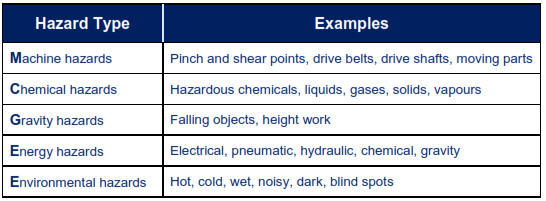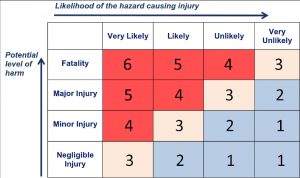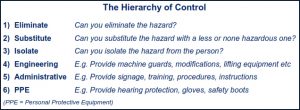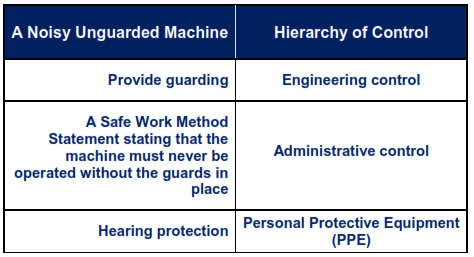WHS for Health and Safety Committeess – NSW Edition
Lesson 4, Topic 1: Risk Management
WHS Risk Management Principles
There are 4 Key Steps in the Risk Management Process:
1) Hazard Identification
The identification of situations that may cause injury
2) Risk Assessment
An evaluation of how serious the identified situation is
3) Risk Control
Eliminating or minimizing the risk that the situation causes an injury
4) Risk Control review
Evaluating whether the choosen risk control method is working as intended
———- NOTE: Consultation must occur through each of the 4 steps ———-
1 – Hazard Identification
A hazard is ANYTHING that could cause injury or illness to a person.
There are a number of ways how hazards can be identified. For example:
1) The use of acronyms that indicate types of hazards e.g.: MCGEE

2) Safety inspections by Health and Safety Committee members and HSRs.
This method typically makes use of checklists that draw attention to hazards that may be present.
3) Ad-hoc incident reporting.
This is a method that enables any worker to formally raise a safety concern at any time.
4) Analysis of injury/illness records.
This is an audit that looks at historical injury/illness data which can be used to identify trends.
5) Incident investigation
An investigation of an incident to identify root and immediate causes with the aim to prevent a recurrence.
6) Your Senses: VISION – HEARING – SMELL
Your senses are amongst the most important hazard identification tools you may ever have. You carry these with you all of the time. Notice what you notice and trust your senses. Ask questions about anything that appears unusual.
2 – Risk Assessment
Risk assessments are about determining the potential for a hazard to cause harm through the evaluation of:
1) The likelihood of the hazard causing harm AND
2) The potential consequence/severity of the injury

An organization should determine what action should be taken for each rating.
For example if a rating of 1-2 was given, the organization might consider the following action:
“Stop the activity immediately until the risk can be managed down to an acceptable level”
When to assess risk
A risk assessment is mandatory for certain high risk activities for example entry into confined spaces, diving work and live electrical work.
Although a risk assessment may not be mandatory under the WHS Regulations, it should be conducted when:
- there is uncertainty about how a hazard may result in injury or illness
- the work activity involves a number of different hazards and there is a lack of understanding about how the hazards may interact with each other to produce new or greater risks
- changes at the workplace occur that may impact on the effectiveness of control measures.
3 – Risk Control
Risk control means to either eliminate the hazard, or, if that is not possible, to manage the hazard down to an acceptable level.
In this process, the law requires us to use the “Hierarchy of Control”.

The Hierarchy of Control can be used as a set of questions that need to be asked about the hazard, from the top down.
Below is an example:

As shown in this example, in many cases it is not unusual to implement multiple levels of control.
4 – Risk Control Review
Once a risk control(s) has been implemented, a review must be carried out to confirm the effectiveness of the chosen control method(s). Consultation must occur during each step of the risk management process.
Note:
Consultation MUST occur during each of the 4 risk management steps

